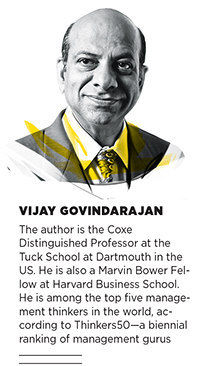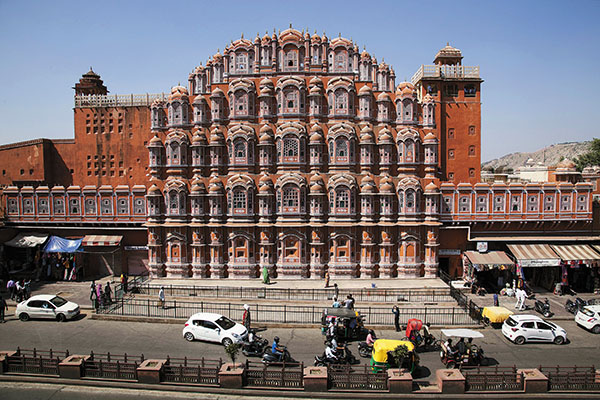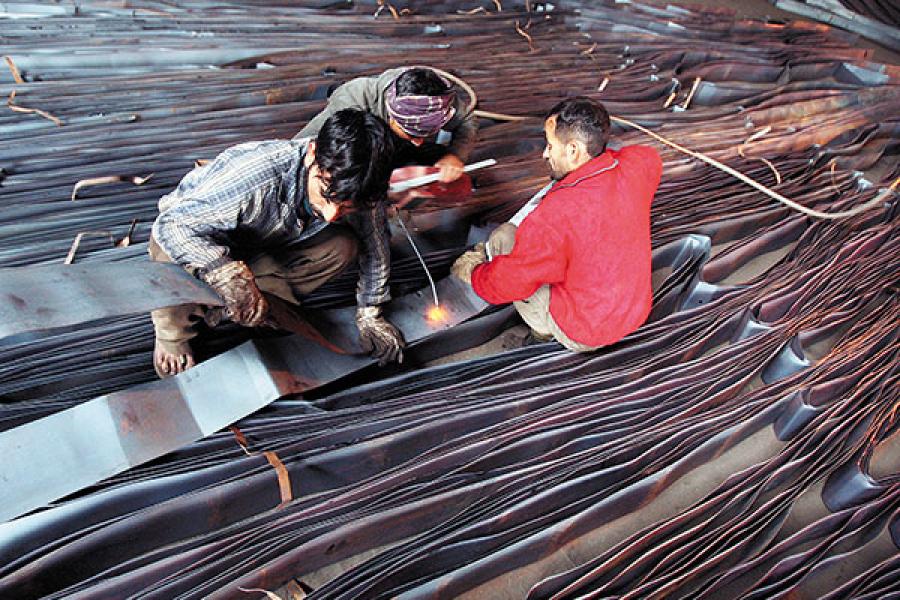
Vijay Govindarajan: We need big, bold ideas
This is a make-or-break budget for India. Game-changing innovations to boost the economy are the need of the hour
 India’s relatively young economic history can be split into three phases. During Phase I, the period from our Independence to 1991, businesses made a lot of profit, that is, as long as they had the required licences. Efficiency did not matter, and companies weren’t expected to know how to spell ‘competition’.
India’s relatively young economic history can be split into three phases. During Phase I, the period from our Independence to 1991, businesses made a lot of profit, that is, as long as they had the required licences. Efficiency did not matter, and companies weren’t expected to know how to spell ‘competition’.
Everything changed with liberalisation in the early 1990s. It marked the beginning of Phase II, which, over the last two decades, has seen India grow as businesses became more efficient. There was so much inefficiency in the system that simply shedding it made the economy healthy.
Game-changing innovation will be the key to unlocking India’s future as we go forward into Phase III. The idea of game-changing innovation came to me while I was watching a Rajinikanth movie: In the climax, the villain ties the actor and kidnaps the heroine in a Mercedes-Benz. The police give chase in a van. The police van plays by the same rules as the Mercedes, but at a slower speed, and the gap between the two vehicles widens. Meanwhile, Rajinikanth manages to untie himself, but he knows that he cannot play by the same rules as the car as he has already lost 10 minutes. He jumps on to a horse. It is a good move because the horse can manoeuvre its way through narrow alleys and even climb a mountain, which the Mercedes (and the police van) cannot do. It’s only a matter of time before Rajinikanth overtakes the car and rescues the heroine. That is thinking out of the box.
For India to become great over the next few decades, we need to think differently. So far, we have been chasing the Mercedes with a police van. That may have worked till now because of the inefficiency in the system. But we need to adopt a different approach. The budget will be a good litmus test to see if we understand the seriousness behind adopting a different approach.

Everything changed in India with liberalisation in the early 1990s. Businesses became more efficient and India became synonymous with growth
The average age in India is about 25 years, and the population is going to age. We have a small window of opportunity to kick-start economic growth and take advantage of the demographic dividend. We do not have a rule book to follow. There are no countries that we can ape. We need to invent our own solutions and come up with breakthrough ideas and innovations to propel us forward.
There are factors acting in our favour: The only brick that is left in Brics is India. Brazil and China are slowing down, and the less said about Russia, the better. India is an attractive proposition for American companies looking to invest. Further, the drop in oil prices has put us in a good spot, allowing the government to cut down the budgetary deficit. Monsoon has been reasonably good, too. One can call this luck, but we should take advantage of this and move forward.
And Prime Minister Narendra Modi has done a phenomenal job in cultivating international relations. He has spent a lot of time visiting the US, Japan and many other countries. If India is to unlock its potential, we need foreign investment—dollars, technology and capabilities. Over the last 10 years, we had a lot of false starts, and people had started to lose hope. Modi has set the right tone, and has been successful in changing perceptions. Some of the CEOs who had met Modi in the US told me that he is “great, and we can do business in India”.
Investors like the direction he has taken, and are now waiting for him to show results. It is in this context that I call it a make- or-break budget for India. We need to now show non-incremental moves. I am not saying we should solve all the problems in this one budget. But people are looking for a few big, bold ideas.
There are three areas that need immediate action. First, the policy framework: Can we make it easy for entrepreneurs to start a business? Can we make our tax system simple? Can we modernise our archaic labour laws? Can we develop more effective ways to enforce laws, including streamlining the process for land acquisition? Can we make our policies consistent, and government more transparent?
Second, public spending: Ultimately “Make in India” will not happen unless local demand is created. The Chinese model of “Made in China” is not the way forward. That model was based on an export-oriented strategy. I don’t think India can sell that story. The Indian model should be rooted in domestic demand with the surplus being exported.
India has a rare opportunity to create that demand because we have scale—a population of 1.2 billion people. The government must strategically increase spending in areas that can generate demand. The Reserve Bank of India’s move to cut interest rates stimulates consumption and is a step in the right direction.
Once demand is created, we need to figure out who will make it. There has been some controversy between India and the US when it came to “Make in India” stipulations. I don’t think we should insist that American companies manufacture products locally, instead of exporting them into India. Instead, our focus should be to create massive local demand. If you simplify policies to start a business, and create huge demand, multinationals will manufacture in India to save on labour and transportation costs. We can create massive employment opportunities this way.
The third area that the budget should focus on is providing incentives for breakthrough innovation targeted at solving complex social problems. I always say that India is not one, but three countries.
India No 1 resides in tier I cities; there are about 12 of them. People in this India are affluent with a per capita income that is five times the national average, say $30 a day. They can afford to buy all the products that are being made by multinationals for rich-world customers.
The inhabitants of India No 2 live in tier II and tier III cities as well as small towns with a per capita income that is in line with the national average of about $5 a day. There are plenty of non-consumers in this category.
Then there is India No 3 comprising residents of 6,00,000 villages where the per capita income is a fraction of the national average, at one dollar a day. Here, the number of non-consumers is high. We need to come out with quality affordable products that will meet the needs of India number two and three. We need to break through the cost floor dramatically. Breakthrough innovation will happen in India No 2 and No 3.
I would like to see what special fiscal incentives the budget will give to companies to take non-consumers seriously, do breakthrough innovations involving the latest technology and unlock this latent demand. In fact, a portion of the India Inclusive Innovation Fund (launched by the government last year) can be used to enable this.
India is ready for this change, and more importantly, the world is ready for India. I am looking for something bold in the budget. It should send out a strong message that this government is not about mere talk, but that it means business. Expectations are high and Modi’s (and India’s) credibility is at stake.
(As told to N Madhavan)
(This story appears in the 06 March, 2015 issue of Forbes India. To visit our Archives, click here.)
-
 Anusha
AnushaI really liked u linked with Rajini..
on Feb 26, 2015 -
 Dr.a.jagadeesh
Dr.a.jagadeeshExcellent. Here are some issues which will improve our Economy and provide employment for your consideration and inclusion in the ensuing budget: To Union Finance Minster: Occupational Promotion Centres The best protection against unemployment is a solid training and constant additions to it. That costs time and money things which must be provided by the learner himself, industry and the state. Investments made in this respect by industry and the State are by no means gifts to unemployed persons. They are investments which pay off, investments which increase productivity, quantitatively and qualitatively. And, on the other hand an unemployed person who does not possess the qualifications which make it possible to reintegrate him into the labour process means expense with no prospect of profit. Well trained young people have the best chances on the labour market. We find lakhs of unemployed youths keeping idle soon after they complete their studies and until they get employment. As they lack proper facilities to receive some useful training their energies are being diverted for wrong ends. 'Occupational Promotion Centres' can be established at district level where they can get free training (part time) in occupations like welding, radio mechanism, drilling, carpentry, glass blowing etc., on technical side, soil testing, water analysis, blood testing etc., on scientific side. This training will go a long way in equipping the trainees with some practical knowledge which will help them to start an industry of their own or in getting some gainful employment. We are having 'Industrial training Institutes', 'Polytechnics' etc., to give training in industrial and technical subjects. But the above centres have a difference from these institutes in that the centres operate on the principle 'Voluntary Learning is more Effective than forced learning'. People with real interest for the training should only be admitted. I personally know many people working as apprentices in private workshops and radio shops to learn the techniques. These are people who are quite new to the field though they have aptitude for that profession. Recently a young high school student designed a microscope which costs just a rupee, purely with limited material available. If such students are permitted to avail the facilities of an established workshop or laboratory, I am sure they can benefit much to improve their inventive talents. There is a hobby centre in S.V. University to give training to University students in fields like radio mechanism, glass blowing etc., which is working very well at Tirupati. The training is free to University students. I suggest the Union Government with the active co-operation of the different State Governments can chalk out a scheme to establish 'Occupational Promotion Centres' in Districts. All that these centres need is a good workshop and a small laboratory with two or three well trained instructors. The above centres will help unemployed youth for gainful employment after training and go a long way in the national reconstruction from grassroot level. At the end of the training, a certificate can be given to the trainees. There should be flexibility in the duration of the training depending on the interest of the trainees. Innovation, Invention and Creativity are the pillars of any society. Why countries like US, Germany, South Korea and for that matter China are advancing, because of innovations in every field. In India recently an Innovation Fund of about 1000 Crores has been set up. Already there are National Research Development Corporation (NRDC), Techno Entrepreneur Propgramme (TePP)of DSIR,National Innovation Foundation(NIF) are working to promote INNOVATIONS and INVENTORS. These are piecemeal in a vast country like ours. Innovative mind does not require higher education or training. There are geniuses everywhere. We have to identify them and nurture them. Often it is difficult to identify the right problem then the solution will automatically follow. I have a novel plan: The Government(Central) ,along with Industrialists and private corporate giants like TATAs,Birlas,Mahindra,,Infosys etc., can create a INNOVATIVE FUND. They can form a secretariat of experts in different fields, NGOs,Scientists & Technologists etc.,. An advertisement can be given in Newspapers, Electronic Media asking people to suggest the problems they face. Huge number of problems will be received from people. These can be shortlisted subject wise and (about 50 to start with) can be identified and readvertised for solutions. The solutions received can be evaluated scrupulously for their innovative nature and the best solutions can be given awards. The award should be of the value of Rs 1 Crore. To catch a fish the bait should bite attractive enough. Is not Amitabh Bachan conducted Kaun Banega Crorepati a roaring success? This programme set in motion a thought process among millions of people. Our Centre has been involved in the DESIGN, DEMONSTRATION and DISSEMINATION of Renewable Energy and Appropriate Technology Gadgets. We have not taken any patents and are willing to share our experience and expertise in promoting our Innovative Devices. INNOVATION FUND & INNOVATION CENTRES IN ENGINEERING COLLEGES In a broader sense, innovation is important to the advancement of society around the world. New and innovative products can increase the standard of living and provide people with opportunities to improve their lives. Breakthroughs in medicine and technology have significantly improved living standards around the world. Innovation has also lead to significant improvements in the way businesses operate and has closed the gaps between different markets. Innovation in engineering: Innovation in engineering is much more than research and development. It encompasses an end-to-end process, such that it extracts value through implementation. Innovation involves: • creating or generating new activities, products, processes and services • seeing things from a different perspective • moving outside the existing paradigms • improving existing processes and functions • disseminating new activities or ideas • adopting things that have been successfully tried elsewhere Innovation covers the area from minor quality improvements to 'cutting edge' products and services. "If we can't find ways to inspire a generation of engineers with varied skills, this is going to be a principle obstacle for growth in our slowly recovering global economy" said Lidia Brito, Director of the Division of Science Policy and Capacity Building at UNESCO. "A recent UNESCO Engineering Report shows a marked shortage of engineers in many countries. Although the general number of engineering students is increasing worldwide, the proportion who enroll in engineering, as compared to other disciplines, is concernedly dropping. We need hands-on challenges like Fly Your Ideas to motivate young innovators about the potential of engineering in helping to find practical solutions to issues the world may face in the near future." Such innovation may be under threat from a skills gap that could be hitting the economy hard. It will see high tech companies face a shortfall of 40 million of the skilled workers needed by 2020 and beyond, with aerospace likely to suffer, along with motor and the medical equipment sectors. Charles Champion, Executive Vice President Engineering at Airbus and Fly Your Ideas Patron, says: "These future-focused and disruptive concepts prove that engineering isn't just about technical skills - it's about having an innovative mindset and a creative approach. But for our industry to succeed in making aviation carbon neutral by 2020, we need a constant source of fresh and inventive ideas from the innovators of today and those of tomorrow. Our future solutions are here right now - and through projects like 'Fly Your Ideas', we are helping them to become a reality for the future." Innovation is extremely important to a country like India as it is closely related to productivity. Although there are a number of avenues to increased productivity, innovation is the most significant factor. Creativity is seeing what everyone sees and thinking what no one else has thought before,Invention is transforming those new thoughts into tangible ideas Innovation goes even further, involving preparedness to mix with the commercial world to turn novel ideas into products . The expertise of the engineering profession is vital to convert innovative ideas into reality for common use. Many of the comforts humankind enjoys today have been the result of innovative engineers. Examples include electrical appliances, transportation, buildings, telecommunications and urban infrastructure. Innovation and technology have become two inseparable words in the annals of human history. Engineers drive technology and are therefore at the forefront of innovation. In India there were efforts to harness the talent and innovative spirit among people by organisations like National Innovation Foundation(NIF),National Research Development Corporation(NRDC),TePP etc. besides some private initiatives(Spark the Rise) etc. In a vast country like ours these are piecemeal. I am glad to read the news item in January this year: Rs 5000 Crore Innovation Fund in India "National Innovation Council Chairman Sam Pitroda today said a Rs 5,000 crore fund to support innovations would be launched soon. "We have an innovation fund that we are launching... a Rs 5,000 crore innovations fund with focus on affordability, scalability and sustainability," Pitroda said on the sidelines of an event here. "The real innovation has to come from the bottom of the pyramid," he added." The amount spent for innovation should help to shape the beneficiaries as entrepreneurs. I have a project: Innovation Centres in Engineering Colleges: Engineers are best suited to innovate. Unfortunately most of the Engineering Colleges like Infrastructure facilities(like Good Workshop, Electronics Lab etc). A Project," INNOVATION CENTRES) in Engineering Colleges can be started under the Rs 5000 Innovation Fund. Selected Colleges can be provided to start a good workshop and Electronics Lab. This way the Students can undertake innovative projects and come out with good gadgets. Later they can patent them and go for commercialization. This is the best way to spend Innovation Fund so that there will be productivity and promotion of Entrepreneurship. Creativity, Innovation and Invention are the Pillars of Progress. Today in Industry, INNOVATE OR PERISH is the MANTRA. Dr.A.Jagadeesh Nellore(AP),India
on Feb 26, 2015















